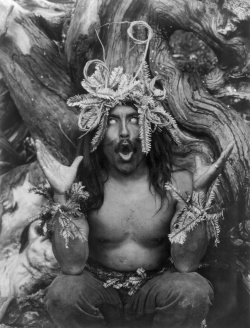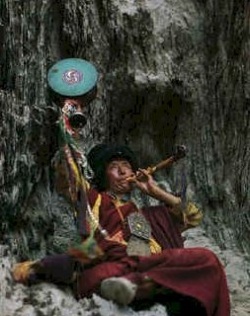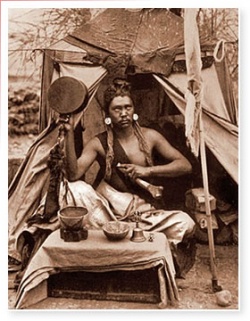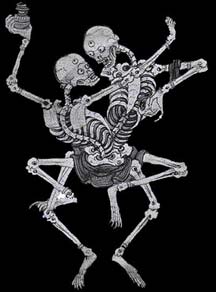A Critical Genealogy of Shamanism in Tibetan Religions - PART IV
Exorcising the Shaman from Bon Studies
During the 1960s and 1970s, Tibetologists such as Rolf Stein, Giuseppe Tucci, David Snellgrove, and Per Kvaerne came to reassess Bon, which consequently lead to the rejection of the category of shamanism by most western scholars specializing in the study of Bon texts. How did such a radical reassessment come about? First, these scholars realized that they cannot follow the dualistic approach of Buddhist purists and regard Bon as Tibet's only other religion, containing all the leftover, marginal, and "superstitious" elements that do not belong to their own elite tradition. In their surveys of Tibetan religion, both Stein and Tucci introduced a new category to describe the popular religion of Tibet. This religion, sometimes referred to in early Tibetan literature as mi chos, the "religion (or customs) of the people," is neither Buddhist nor Bon but is understood to be Tibet's indigenous tradition. Stein names this the "nameless religion,"[1] while Tucci calls it the "folk religion." For both scholars it serves as the ancient religious substratum of Tibet: all that is not specifically Buddhist or Bon is relegated to this category.
This religious substratum was reconstructed from two kinds of historical sources: the ancient Tibetan texts recovered from Dunhuang that had received little attention from earlier scholars, as well as later Bon and Buddhist sources. While we might expect a more precise picture of Bon to emerge, what is interesting about both of their surveys is that the problematic Bon tradition is dealt with last, after Buddhism (or "Lamaism") and the "folk" or "nameless" religion are carefully delineated. Despite the discovery of another popular religion in Tibet, and its displacement of Bon as the indigenous substratum, the boundaries between Buddhism, Bon and the folk (or "nameless") religion can hardly be fixed. One of Stein's major contributions to the study of early Tibetan religion rests on his distinction between Bon and the substratum of the non-Buddhist folk tradition (mi chos), which he calls "the nameless tradition." Of course the very fact that Stein names this latter "tradition" at all has important consequences for recognizing and validating it. But the dividing line between all three Tibetan religions can only be murky and obscure, as he remarks in his concluding comments about assimilated Bon: The beliefs of systematized and adapted Bon are consequently identical with Nyingma-pa doctrines, apart from names and technical terms. The rest of Bon merges to a large extent with the nameless religion discussed earlier. Is this because Bon by itself really represented that indigenous tradition, as is often thought? Or is it because the Bon sorcerers necessarily had to relate to and integrate with it? It is hard to tell, in absence of any specifically Bon exposé of their religion.
These are questions that remain unanswered today, for no "specifically Bonpo exposé" has yet been revealed with the answers to all our questions about the boundaries between Bon, Buddhism, and Tibet's indigenous religion-nor will this likely ever happen. The very idea that such a "Bonpo exposé" exists rests on the assumption that there was once a discrete Bon tradition in the distant past, prior to becoming all mixed up with Buddhism or Tibetan popular religion. Tucci also notes the difficulty of distinguishing between Buddhism, Bon, and the "folk religion," but he adds that Bon manifests distinct phases in its development, each in succession reflecting higher degrees of synthesis: If we are discussing the Bon religion only at the end of our account it is, among other things, because our preceding descriptions, especially of the folk religion, and of certain special aspects of Lamaism, have in some degree opened the way to understanding Bon. If we can disregard some short texts found in Central Asia, we can deduce that the pre-Buddhist religion of Tibet had to undergo a vast process of evolution to become able to compete with the incomparably more solid doctrinal structure of Buddhism.[2] When Tucci turns his attention to analyzing how Bon developed within the context of Tibet's social transformations, he relies entirely upon the "traditions that have come down to us" in the three-fold system of the Crystal Mirror of Doctrinal Systems.[3] Evidently it is the text's "handed down" or "given" quality (a crucial characteristic of all canonical texts) that keeps Tucci from critically interrogating its content and categories ('jol bon, 'khyar bon, 'gyur bon). Reading Tucci's analysis of these phases produces an eerie feeling of déjà vu all over again.[4] So what exactly is Bon for Stein and Tucci? Together they might answer that Bon includes both of the above (Buddhism and popular religion) and a little more. That is, they agree that Bon is syncretic, adopting and adapting Buddhist and popular religious themes. But what determines the unique identity of Bon is that it has its own canon, a system for classifying its "own" teachings, its own cosmogonies and theogonies, and a lineage stemming from its own founder. There is an important shift here towards recognizing the indigenous categories found in Bon literature as legitimate, or at least as legitimizing a distinct identity. Yet the brief resumes of Bon by Stein and Tucci are still quite indebted to Buddhist polemical literature. The CMDS in particular informs their presentation of how Bon "evolved" from a simple religion preoccupied with apotropaic rites, divination, and magic, to a state supported religion featuring a royal mortuary cult, and finally to a religion with a sophisticated doctrinal "superstructure," lifted mostly from Buddhism, as well as from Kashmir ⁄ aivism, Gnosticism, and Manicheanism.[5]
With the displacement of Bon as Tibet's non-Buddhist popular religion, there developed a much more critical attitude toward labeling Bon simply as a form of shamanism, especially as defined by Eliade and supported by the textual and ethnographic examples of Hoffmann and Nebesky-Wojkowitz. Stein and Tucci both found little evidence of the ecstatic trance state of the shaman in Bon rituals. Likewise, they found no support for the "supreme being ideology" that Eliade argued was so central to shamanism. Tucci explicitly rejected Hoffmann's claim that Bonpos believed exclusively in Heaven, personified as a celestial being and understood as a deus otiosus; thus Tucci denies that Bonpos ever subscribed to a version of the shamanic "supreme being ideology."[6] Too, Stein and Tucci recognize that many of the shamanic motifs singled out by earlier scholars are found in Indian Tantric literature, and they question whether these elements were historically disseminated into Tibet from central Asia, as Hoffmann had suggested. Nonetheless, Tucci accepts that many of the shamanic motifs do appear in the ritual roles of early Bon priests, who were described as riding though the air, magically using their drums, and calling back the souls of the dead or dying.[7]
Stein, on the other hand, remains more skeptical than Tucci about labeling such practices as shamanic, pointing out that the funerary and healing rites performed by Bon priests were concerned primarily with the details of ritual syntax, with no sign of the priests breaking out into any spontaneous ecstatic trance.[8] Stein also notes that the stereotypical description of the blue-caped, long-haired Bonpos flying through the air astride a drum may sound shamanic, but this drum riding feat is also found among Indian siddhas. Moreover, Tibetan Buddhist writers attribute blue capes and long hair to any "heretic," whether it be Bonpos, Shivaites, aberrant Tantrists, or those generally hostile to Buddhism.[9] [10]. Snellgrove and Kvaerne continue this exacting critique of Bon "shamanism," mostly from the standpoint of textual specialists and philologists who argue that this western category does little to elucidate Bon literature and rituals.
Their close reading of Bon texts paid less attention to the antagonistic voices of Buddhists and relied instead upon the cooperation of contemporary Bonpo scholars, who helped them understand these texts from "inside" Bon orthodoxy. Thus their revisionist representations of Bon coincided with their cooperation with Bonpo Geshes (Dge bshes), who knew nothing about the foreign category of "shamanism." Snellgrove must be recognized as the first western scholar to "discover" these Bonpo "treasures" (like a Tibetan gter ston). With the sponsorship of the Rockefeller Foundation he invited three Tibetan Bonpo monks to study at the University of London and collaborate with him on a translation of chapters from the Gzi brjid, which was published as The Nine Ways of Bon. Snellgrove's action served to legitimize or "consecrate" the Bon tradition in at least three ways. First, The Nine Ways of Bon offered a systematic summary of genuinely "canonical" teachings (from the Bonpos' perspective) and its difficult technical terminology was explained with the assistance of Bonpo scholar-monks. Second, when two of the Bonpo monks, Tenzin Namdak and Sangye Tenzin, returned to India they eventually established the first Bon monastery in exile at Dolanji, with the financial backing of western aid organizations. Tenzin Namdak and Sangye Tenzin, who became the chief teacher and the abbot respectively at this monastery, also initiated a publishing venture so that scores of Bon canonical works were published and disseminated to western libraries, such as the American university libraries designated as the repositories for India PL-480 texts. Third, the remaining Bonpo monk, Samten Karmay, stayed at the University of London to study under Snellgrove, and he became one of the pre-eminent scholars of Bon to write in both English and French. In 1972 Karmay published the first Bon history of Tibet in English, The Treasury of Good Sayings, followed by "A General Introduction to the History and Doctrines of Bon" in 1975, both of which superceded the superficial summary of Bon found in the CMDS.[11]
As a result of Snellgrove's "discovery" then, and due to the industriousness of these Bonpo monk-scholars, the new historical picture of Bon that began to emerge in the west during the 1970s came much closer than any previous portrait to understanding Bon from within. This transformed Bonpos from mere objects being acted upon to actors in their own right. Yet the revisionist picture of Bon that Snellgrove and Kvaerne produced was not very sympathetic to the claims made by Bonpos that their tradition was the authentic and original religion of Tibet, predating Buddhism. Rather, they regarded Bon as a heterodox form of Tibetan Buddhism that emerged only as a distinct constituted tradition in the eleventh century. Yet even then it was already syncretic, drawing upon the Buddhist and popular traditions of Tibet, as well as religious elements from other cultures (central Asian shamanism excepted). Snellgrove and Kvaerne dismissed as misdirected their predecessors' quest to recover a pure Bon prior to Buddhism. While [[Wikipedia:David Snellgrove|Snellgrove] notes the importance of gaining the Bonpos' own "insider's" perspective on their history and literature, this becomes problematic in understanding pre-Buddhist Bon. He writes in his Introduction to The Nine Ways of Bon: In giving an account of any religion we cannot ignore what the practisers say about themselves.... In the case of the bonpos we have to accept them and understand them as they are, while still trying to unravel the historical development of their religion. An understanding of them on their own terms is all the more important nowadays, because we need the assistance of their few remaining scholars in order to understand something of their early texts. Tibetans who can help with these texts are now very rare indeed. Educated bonpo monks are brought up in the dGe lugs pa (‘Yellow Hat') Way, trained in conventional Buddhist philosophy and logic and receiving after examination by debate the academic degree of dGe bshes. They know their monastic liturgies and the names of their own bonpo gods, but very rarely indeed are they at all experienced in reading the sort of bonpo texts in which we most need assistance, namely material which represents ‘pre-Buddhist' traditions. This lack of familiarity on the part of present-day bonpos with what Western scholars would regard as real bon material, may come as a disappointment.[12] Snellgrove here identifies one of the challenges that a philologist or historian faces in working with native scholar informants to read historical texts. The Bonpos' familiarity with the web of intertextual allusions and with the exegetical commentaries on key concepts found in any work of Bon literature makes them very valuable informants. However, the Bonpos' lack of interest in or awareness of the historical development of their literature often leads them to read ancient texts in an anachronistic manner.
Moreover, many of the divination practices (mo), astrological calculations (rtsis), methods of medical diagnosis (dpyad), and rituals for placating gods and demons (gto) that one finds in Bon literature employ an archaic vocabulary that is unfamiliar to contemporary Bon scholars, since these practices are no longer part of the living Bon tradition. Here the historian might be better served by comparing the descriptions of these practices to what appears in the archaic Dunhuang manuscripts and ancient epigraphy on these topics, while recognizing how problematic it would be to identify such practices as belonging either to the indigenous religion or to pre-Buddhist Bon. From the perspective of Snellgrove, Kvaerne, and subsequent scholars of Bon literature like Blondeau and Martin, the interest that earlier European scholars had in locating the Bon "shaman" was misplaced. From their critical perspective the Bon "shaman" becomes somewhat of a scapegoat, representing the ignorance of these earlier scholars, a scapegoat better banished in future discussions of this religion. One of the effects of their collaboration with Bon informants is their desire to police the boundaries of "Bon" as an object of western investigation, and forbid the use of the foreign term "shamanism." However, the desire to exorcize the "shaman" from discourse on Tibetan religion has proved unsuccessful, as contemporary anthropologists and new-age enthusiasts have redefined the term. "Shamanism" has proved to be an elastic and elusive term, and much like "fetishism" or "totemism" it has been reclaimed from its earlier pejorative connotations by current anthropological usage.[13]
The desire to delineate and deflate "shamanism" as a powerful yet insubstantial notion echoes the analysis of "totemism" by Claude Lévi-Strauss. In his groundbreaking study on Totemism, Lévi-Strauss presented one of the first critical deconstrutions and reconstructions of an anthropological category. His chapter on the "Totemic Illusion" opens with the following profound insight: To accept as a theme for discussion a category that one believes to be false always entails a risk, simply by the attention that is paid to it, of entertaining some illusion about its reality. In order to come to grips with an imprecise obstacle one emphasizes its contours where all one really wants is to demonstrate their insubstantiality, for in attacking an ill-founded theory the critic begins by paying it a kind of respect. The phantom which is imprudently summoned up, in the hope of exorcising it for good, vanishes only to reappear, and closer than one imagines to the place where it was at first.[14] For Lévi-Strauss, the category of "totemism" is an illusory one, a reified concept that has haunted the minds of many western anthropologists, both ghostly and ghastly. What disturbs Lévi-Strauss about the ghost of "totemism" is how it has been projected by anthropologists into the unsuspecting minds of "primitive" peoples, marking them as "savage" or "other", literally akin to animals and plants. Especially repugnant to civilized Christians, the category of totemism affirms continuity between man and beasts, an extremely "primitive" or "pagan" idea.[15] Thus "totemism", much like "hysteria" claims Lévi-Strauss, was created by western scientific minds to distance themselves from the abnormal and immoral other. As self-appointed exorcist, Lévi-Strauss intends to demonstrate the illusory quality of this category. But before he can disillusion his fellow anthropologists he first must reconstruct their images of totemism, which effectively reactivates their potency. Thus the paradox of "entertaining some illusion about its reality," for merely by paying respect to their illusions, those illusions may come to have a life of their own. Such is the risk Lévi-Strauss runs in debunking this potent western category, which has had the real effect of separating us from them. Yet our author suggests mysteriously that even after the phantom of totemism seems effectively eliminated, it reappears even closer than one imagines to the place where it was at first. Hitchcock has shown us that to give away the ending does not eliminate all suspense in a narrative, so I will give away his conclusion, in anticipation of another argument advanced by an anthropologist. Lévi-Strauss believes that totemism is in fact not "out there" in the archaic minds of savages, but its truth is found within all our intellects, as a certain mode of metaphorical thinking. For some anthropologists of Tibet too, "shamanism" is to be identified as a mode of analogical thinking that includes "totemism."[16] Despite the strenuous efforts by textual scholars of Bon to eliminate "shamanism" from scholarship on Tibetan religion, the term has reappeared in the work of anthropologists, New Age enthusiasts, and even among the Bonpos themselves: shamanism appears even closer than one imagines to the place where it was at first.
Continue Reading
- A Critical Genealogy of Shamanism in Tibetan Religions PART I: Introduction
- A Critical Genealogy of Shamanism in Tibetan Religions - PART II
- A Critical Genealogy of Shamanism in Tibetan Religions - PART III
- A Critical Genealogy of Shamanism in Tibetan Religions - PART IV
- A Critical Genealogy of Shamanism in Tibetan Religions - PART V
- A Critical Genealogy of Shamanism in Tibetan Religions - PART VI
Footnotes
- ↑ Rolf Stein, Tibetan Civilization, p. 191. Stein addresses the problem of locating Tibet's indigenous religion, and how it differs from both Buddhism (or Lamaism) and Bon: "It would be a mistake to suppose, however, that all non-Buddhist elements absorbed by Lamaism in Tibet were indigenous. Tibetan historians themselves have clouded the issue by constantly mixing up two separate points: the fact that Bon was there before Buddhism, and the judgment that everything preceding the latter religion was naturally ‘barbarous', uncivilized and appropriate to an age of darkness. Hence the somewhat oversimplified conclusion drawn by early European students, who tended to present Bon as the primitive religion of Tibet. Further, by equating ‘primitive' with ‘savage,' everything in Lamaism that seemed frightening, twisted and demonic or mediumistic soon came to be regarded as Bonpo and primitive. From that to describing it all as ‘Shamanism' was but a step. The truth is more complex. It is often impossible to tell which of Lamaism's not specifically Buddhist elements is indigenous and which foreign, which one was really Bonpo and which was not." Stein here presents a very clear analysis of European misconceptions of "primitive" Bon and how Buddhist texts have lent support for these misunderstandings. 79 Giuseppe Tucci, The Religions of Tibet, trans. by Geoffrey Samuel (Berkeley: University of California Press, 1988), pp. 163-212. It first appeared as Die Religionen Tibets und der Mongolei by Tucci and Walther Heissig (Stuttgart, 1970). 80 Rolf Stein, Tibetan Civilization, p. 241.
- ↑ Giuseppe Tucci, The Religions of Tibet, p. 213.
- ↑ Giuseppe Tucci, The Religions of Tibet, p. 224.
- ↑ Tucci himself insists that the model of religious development found in the CMDS corresponds to an "inner law", namely that the tradition develops naturally from its primordial state to a more sophisticated religion, overseen by a priestly class with unique powers distinct from the king's. He explains on p. 224 of The Religions of Tibet that "from a primitive starting-point of purely magical or shamanistic character, varying from place to place, we come in the time of Grigum (who doubtless indicates an especially significant factor in the development of the Bon religion) to the first beginnings of an organizational process probably brought about through the contrast between the royal authority and the magical powers of Bon." Such a statement about the "inner law" of religious evolution is revealing, not so much for its insight into the actual development of Bon, nor as an explanation of what Thu'u bkvan "really meant;" rather, it tells us that Tucci (like so many earlier historians of religion) regarded this model as a universal pattern for explaining change in "primitive" religions.
- ↑ Stein, Tibetan Civilization, p. 232. Stein uses the CMDS historical overview of Bon a bit more critically than the other scholars discussed, although not any more sparingly. His method for reconstructing the history of Bon relies upon the narratives present in Thu'u bkvan's text as well as in other Tibetan Buddhist histories. He enumerates all three phases of Bon development, but devotes most of his attention to the second and third phases. He refuses to speculate about the nature of what he calls "revealed Bon," and to his credit, he eschews the categories of animism and shamanism altogether. Yet when narrating the second phase of "deviant Bon" he presents the story of the three foreign Bonpos being invited to Tibet as if it were a historical event. Furthermore, he suggests that Thu'u bkvan's theory of ⁄aivite influence is plausible, adding on page 247 that Taoist, Manichaean, and Gnostic influences are possible as well.
- ↑ Tucci writes in The Religions of Tibet, p. 218: "Nothing however allows one to define Bon as a religion characterized exclusively by the worship of heaven. Such worship only takes place in special circumstances and at particular moments, that is when there is mention of a gnam bon a "Bon of heaven." Then again on p. 246 he writes: "One scarcely does justice to the old Bon religion if one affirms it is a religion of the sky, although certain Bon concepts (e.g. gnam bon) could justify this name." Tucci's criticism here is explicitly directed against Hoffmann, but Hoffmann was simply reinforcing Eliade's theory that shamanism must have a sky or heaven orientation for its supreme being ideology. In both Buddhist and Bon polemical literature one way the Tibetan writer would dismiss his opponents was to claim that they "like the sky/heaven" (gnam la dga'). This phrase is used by both Nelpa Pandita and Sum pa mkhan po in reference to Bonpos, when Bonpos advance the claim that the very first king of Tibet, Gnya' khri btsan po, descended from the sky, rather than from a royal lineage traced back to India. In their polemic, "liking the sky" is a mark of primitivism, perhaps comparable to the 19th century images of primitive "nature worship." The phrase evokes the na飗e reverence paid to the skies or heavens, a mundane focus on the visible. Bon writers themselves also used this polemical strategy, as Kvaerne noted in the Gzi brjid there is a rejection of Mongolian religious practices as based simply on reverence for heaven. See Per Kvaerne's article "Mongols and Khitans in a 14th-century Tibetan Bonpo Text," Acta Orientalia Hungaricae 34 (1980), pp. 89.
- ↑ Tucci, The Religions of Tibet, p. 241.
- ↑ Stein, Tibetan Civilization, p. 238.
- ↑ Stein, Tibetan Civilization, p. 235.Also see footnote 10
- ↑ Thu'u bkvan, Thu'u bkvan grub mtha', p. 382. Sarat Chandra Das identifies sham thabs sngon po can in his Dictionary (p. 1231) as "a T顁thika Pandit who preached a perverse system of Tantra and used to wear a blue petticoat," and he cites a passage from the Biography of Atisa (Jo bo rje Ati sha'i rnam thar). This passage is translated in his Indian Pandits in the Land of Snows ed. by Nobin Chandra Das (Calcutta: Baptist Mission Press, 1893, reprinted New Delhi: Asian Educational Services, 1992), p. 56: "A certain heretic priest of the blue robe order has been preaching immorality and obscene doctrine. By admixture of these foreign elements the sacred doctrine of Buddha has been very much debased." This bluerobed Pandit frequently appears in Tibetan polemical literature, sometimes representing the perverse and lustful nature of Bon clerics (who wear blue robes), but at other times representing Buddhist tantrikas gone bad. This emblematic figure appears in a song attributed to Milarepa, when he is debating with a Bon priest and arguing why it is nonsense to believe that Bon is the "elder brother" of Buddhism. Here is an excerpt from Milarepa's song that provides a humorous etiology for the "blue-robed Pandit": "According to more modern sources [sings Milarepa] a very clever Buddhist pandit in the land of India visited the house of a whore. Arising before dawn, he dressed, but by mistake wrapped himself in the woman's skirt instead of his own. Returning to the monastery at dawn, he was seen wearing the blue skirt and expelled from the community. He made his way eventually to Tibet and with hard feelings in this land of exile created a perverse religion and named it Bon." From the Rje tsun Mi la ras pa rdo rje' mgyur druk sogs gsung rgyun thor bu ba 'ga', trans. by Lama Kunga Rimpoche and Brian Cutillo in Drinking the Mountain Stream: New Stories and Songs by Milarepa, (Lotsawa Press, 1978), p. 148.
- ↑ Samten Karmay, "A General Introduction to the History and Doctrines of Bon" in Memoires of the Research Department of the T魕o Bunk , vol. 33, (1975), pp. 171-218.
- ↑ David Snellgrove, The Nine Ways of Bon, p. 2.
- ↑ For some revisionist interpretations of fetishism as a useful category in anthropological discourse, see Emily Apter and William Pietz, eds. Fetishism as Cultural Discourse (Ithaca: Cornell University Press, 1993).
- ↑ Claude Lévi-Strauss, Totemism, trans. by Rodney Needham (Boston: Beacon Press, 1963), p. 15.
- ↑ Lévi-Strauss, Totemism, p. 3.
- ↑ Geoffrey Samuel, "Early Buddhism in Tibet: Some Anthropological Perspectives" in Soundings in Tibetan Civilization, ed. by Barbara Nimri Aziz and Matthew Kapstein, (Delhi: Manohar Publications, 1985), pp. 384.
Source




